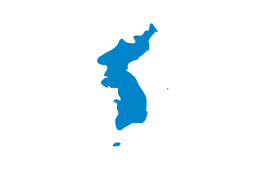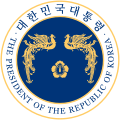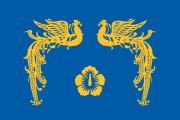Syngman Rhee
Syngman Rhee (Korean: 이승만, pronounced [i.sɯŋ.man][note 1]; 26 March 1875 – 19 July 1965) was a South Korean politician who served as the first President of South Korea, from 1948 to 1960. Rhee was also the first and last president of the Provisional Government of the Republic of Korea from 1919 to his impeachment in 1925 and from 1947 to 1948. As President of South Korea, Rhee's government was characterised by authoritarianism, corruption, limited economic development, strong anti-communism and by the late 1950s growing political instability and public opposition. He imbued the country with a tradition of authoritarian rule that lasted, with a few short breaks, until 1988.
Syngman Rhee | |
|---|---|
이승만(李承晩) | |
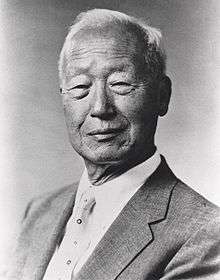 Rhee in 1956 | |
| 1st President of South Korea | |
| In office 24 July 1948 – 26 April 1960 | |
| Vice President | Yi Si-yeong Kim Seong-su Ham Tae-young Chang Myon Yun Posun |
| Preceded by | Office established |
| Succeeded by | Yun Posun |
| Speaker of the National Assembly | |
| In office 31 May 1948 – 24 July 1948 | |
| Preceded by | Office established |
| Succeeded by | Shin Ik-hee |
| Chairman of the State Council of the Provisional Government of the Republic of Korea | |
| In office 3 March 1947 – 15 August 1948 | |
| Deputy | Kim Gu |
| Preceded by | Kim Gu |
| Succeeded by | Office abolished |
| President of the Provisional Government of the Republic of Korea | |
| In office 11 September 1919 – 23 March 1925 | |
| Prime Minister | Yi Donghwi Yi Dongnyeong Sin Gyu-sik No Baek-rin Park Eunsik |
| Preceded by | Office established |
| Succeeded by | Park Eunsik |
| Personal details | |
| Born | Rhee Syngman 26 March 1875 Neungnae-dong, Daegyeong-ri, Masan-myeon, Pyeongsan County, Hwanghae, Joseon (now North Hwanghae, North Korea) |
| Died | 19 July 1965 (aged 90) Honolulu, Hawaii, U.S. |
| Resting place | Seoul National Cemetery, Seoul, South Korea |
| Nationality | Korean (1875–1910) Japanese (1910–1945) South Korean (1945–1965) |
| Political party | Liberal |
| Spouse(s) | Francesca Donner Rhee ( m. 1934–1965) |
| Alma mater | George Washington University (B.A.) Harvard University (M.A.) Princeton University (PhD) |
| Signature |  |
| Korean name | |
| Hangul | 이승만/리승만 |
| Hanja | 李承晩 |
| Revised Romanization | I Seung(-)man / Ri Seung(-)man |
| McCune–Reischauer | Yi Sŭngman / Ri Sŭngman |
Born in Hwanghae Province, Joseon, Rhee attended an American Methodist school, where he converted to Christianity. He became involved in anti-Japanese activities after the 1894–95 First Sino-Japanese War and was imprisoned in 1899. Released in 1904, he moved to the United States, where he obtained degrees from American universities and met President Theodore Roosevelt. After a brief 1910–12 return to Korea, he moved to Hawaii in 1913. From 1918 to 1924, he was promoted to several high positions in some Korean provisional governments and served as a representative of these to Western powers. He moved to Washington, D.C., in 1939. In 1945, he was returned to US-controlled Korea by the US military, and on 20 July 1948 he was elected President of the Republic of Korea with 92.7% of the vote, beating Kim Gu.
Rhee adopted a hardline anti-communist and pro-American stance as President. Early on in his presidency, his government put down an anti-imperialist uprising on Jeju Island, and the Mungyeong and Bodo League massacres were committed against suspected communist sympathisers, leaving at least 100,000 people dead.[1] Rhee oversaw the outbreak of the Korean War (1950–1953), in which North Korea invaded South Korea. He refused to sign the armistice agreement that ended the war, wishing to have reunited the peninsula by force.[2][3]
After the fighting ended, the country remained at a low level economically, lagging behind North Korea, and was heavily reliant on U.S. aid. After being re-elected in 1956, the constitution was modified to remove the two-term restriction, despite protests from the opposition. He was elected uncontested in March 1960, after his opponent Cho Byeong-ok died before voting day. After Rhee's ally Lee Ki-poong won the corresponding vice-presidential election by a wide margin, the opposition rejected the result as rigged, which triggered protests. These escalated into the student-led April Revolution when police shot demonstrators in Masan, which forced Rhee to resign on 26 April and ultimately led to the establishment of the Second Republic of Korea. On 28 April, as protesters converged on the presidential palace, the CIA covertly flew him out to Honolulu, Hawaii, where he spent the rest of his life in exile. He died of a stroke in 1965.
Early life and career
Early life (1875–95)
Syngman Rhee was born on 19 February 1875 in the Korean lunisolar calendar (also stated as 26 March 1875) in Daegyeong, a village in Pyeongsan County, Hwanghae Province of Joseon-ruled Korea.[4][5][6][7] Rhee was the third but only surviving son out of three brothers and two sisters (his two older brothers both died in infancy) in a rural family of modest means.[4] Rhee's family traced its lineage back to King Taejong of Joseon, and was a 16th-generation descendant of Grand Prince Yangnyeong.[8]
In 1877, at the age of two-years-old, Rhee and his family moved to Seoul, where he had traditional Confucian education in various seodang in Nakdong (낙동; 駱洞) and Dodong (도동; 桃洞).[9] When Rhee was nine-years-old a smallpox infection rendered him virtually blind until he was cured by Horace Newton Allen, an American medical missionary.[8] Rhee was portrayed as a potential candidate for the gwageo, the traditional Korean civil service examination, but in 1894 reforms abolished the gwageo system, and in April he enrolled in the Pai Chai School (배재학당; 培材學堂), an American Methodist school, where he converted to Christianity.[4][6][7][10] Rhee studied English and sinhakmun (신학문; 新學問; lit. new subjects). Near the end of 1895, he joined a Hyeopseong Club (협성회; 協成會) created by Seo Jae-pil, who returned from the United States after his exile following the Gapsin Coup. He worked as the head and the main writer of the newspapers Hyeopseong-hoe Hoebo (협성회 회보; 協成會會報; lit. Hyeopseong Club Newsletter) and Maeil Shinmun (매일신문; 每日新聞; lit. The Daily Newspaper),[9] the latter being the first daily newspaper in Korea.[10] During this period, Rhee earned money by teaching the Korean language to Americans. In 1895, Rhee graduated from Pai Chai School.[4]
Independence activities (1896–1904)
Rhee became involved in Anti-Japanese circles after the end of the First Sino-Japanese War in 1895, which saw Joseon passed from the Chinese sphere of influence to the Japanese. Rhee was implicated in a plot to take revenge for the assassination of Empress Myeongseong, the wife of King Gojong who was assassinated by Japanese agents, however, a female American physician helped him avoid the charges. Rhee acted as one of the forerunners of the Korean independence movement through grassroots organizations such as the Hyeopseong Club and the Independence Club (독립협회; 獨立協會). Rhee organized several protests against corruption and the influences of the Japan and the Russian Empire.[10] As a result, in November 1898, Rhee attained the rank of Uigwan (의관; 議官) in the Imperial Legislature, the Jungchuwon (중추원; 中樞院).[9]
After entering civil service, Rhee was implicated in a plot to remove King Gojong from power through the recruitment of Park Yeong-hyo. As a result, Rhee was imprisoned in the Gyeongmucheong Prison (경무청; 警務廳) in January 1899.[9] Other sources place the year arrested as 1897 and 1898.[4][6][7][10] Rhee attempted to escape on the 20th day of imprisonment but was caught and was sentenced to life imprisonment through the Pyeongniwon (평리원; 平理院). He was imprisoned in the Hanseong Prison (한성감옥서; 漢城監獄署). In prison, Rhee translated and compiled The Sino–Japanese War Record (청일전기; 淸日戰紀), wrote The Spirit of Independence (독립정신; 獨立精神), compiled the New English–Korean Dictionary (신영한사전; 新英韓辭典) and wrote in the Imperial Newspaper (제국신문; 帝國新聞).[9] He was also tortured.[10]
Political activities in the U.S. (1904–10, 1912–45), China and Korea (1910–12)

In 1904, Rhee was released from prison at the outbreak of the Russo-Japanese War with the help of Min Young-hwan.[4] In November 1904, with the help of Min Yeong-hwan and Han Gyu-seol (한규설; 韓圭卨), Rhee moved to the United States. In August 1905, Rhee and Yun Byeong-gu (윤병구; 尹炳求)[9] met with the Secretary of State John Hay and U.S. President Theodore Roosevelt at peace talks in Portsmouth, New Hampshire and attempted unsuccessfully to convince the US to help preserve independence for Korea.[11]
Rhee continued to stay in the United States; this move has been described as an "exile."[10] He obtained a Bachelor of Arts from George Washington University in 1907, and a Master of Arts from Harvard University in 1908.[4][8] In 1910,[4] he obtained a PhD from Princeton University[6][7] with the thesis "Neutrality as influenced by the United States" (미국의 영향하에 발달된 국제법상 중립).[9]
In August 1910, Rhee returned to Japanese occupied Korea.[9][note 2] He served as a YMCA coordinator and missionary.[12][13] In 1912, Rhee was implicated in the 105-Man Incident,[9] and was shortly arrested.[4] However, he fled to the United States in 1912[6] with M. C. Harris's rationale that Rhee was going to participate in the general meeting of Methodists in Minneapolis as the Korean representative.[9][note 3]
In the United States, Rhee attempted to convince Woodrow Wilson to help the people involved in the 105-Man Incident, but failed to bring any change. Soon afterwards, he met Park Yong-man, who was in Nebraska at the time. In February 1913, as a consequence of the meeting, he moved to Honolulu, Hawai'i and took over the Han-in Jung-ang Academy (한인중앙학원; 韓人中央學園).[9] In Hawaii, he began to publish the Pacific Ocean Magazine (태평양잡지; 太平洋雜誌).[4] In 1918, he established the Han-in Christian Church (한인기독교회; 韓人基督敎會). During this period, he opposed Park Yong-man's stance on foreign relations of Korea and brought about a split in the community.[9] In December 1918, he was chosen as one of the Korean representatives to the Paris Peace Conference in 1919 by the Korean National Association (대한인 국민회; 大韓人國民會) but failed to obtain permission to travel to Paris. After giving up travelling to Paris, Rhee held the First Korean Congress (한인대표자대회) in Philadelphia with Seo Jae-pil to make plans for the declaration and action of independence of Korea.[9]
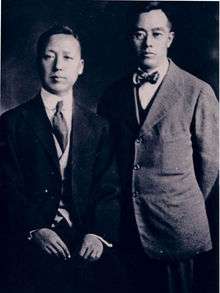
Following the March 1st Movement in March 1919, Rhee discovered that he was appointed to the positions of foreign minister in the Noryeong Provisional Government (노령임시정부; 露領臨時政府), prime minister for the Provisional Government of the Republic of Korea in Shanghai, and a position equivalent to President for the Hansung Provisional Government (한성임시정부; 漢城臨時政府). In June, in the acting capacity of the President of the Republic of Korea, he notified the prime ministers and the chairmen of peace conferences of Korea's independence. On 25 August, Rhee established the Korean Commission to America and Europe (구미위원부; 歐美委員部) in Washington, D.C. On 6 September, Rhee discovered that he had been appointed acting president for the Provisional Government in Shanghai.[6][7] From December 1920 to May 1921, he moved to Shanghai and was the acting president for the Provisional Government.[9]
However, Rhee failed to efficiently act in the capacity of Acting President due to conflicts inside the provisional government in Shanghai. In October 1920, he returned to the US to participate in the Washington Naval Conference. During the conference, he attempted to set the problem of Korean independence as part of the agenda and campaigned for independence but was unsuccessful.[4][9] In September 1922, he returned to Hawaii to focus on publication, education, and religion. In November 1924, Rhee was appointed the position of President-for-Life in the Korean Comrade Society (대한인동지회; 大韓人同志會).[9]
In March 1925, Rhee was impeached as the president of the Provisional Government in Shanghai over allegations of misuse of power[14] and was removed from office. Nevertheless, he continued to claim the position of President by referring to the Hansung Provisional Government and continued independence activities through the Korean Commission to America and Europe. In the beginning of 1933, he participated in the League of Nations conference in Geneva to bring up the question of Korean independence.[9]
In November 1939, Rhee and his wife left Hawaii for Washington, D.C.[15] He focused on writing the book Japan Inside Out and published it during the summer of 1941. With the attack on Pearl Harbor and the consequent Pacific War, which began in December 1941, Rhee used his position as the chairman of the foreign relations department of the provisional government in Chongqing to convince President Franklin D. Roosevelt and the United States Department of State to approve the existence of the Korean provisional government. As part of this plan, he cooperated with anti-Japan strategies conducted by the U.S. Office of Strategic Services. In 1945, he participated in the United Nations Conference on International Organization as the leader of the Korean representatives to request the participation of the Korean provisional government.[9]
Presidency
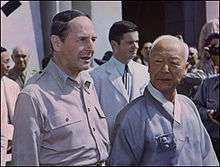
Return to Korea and rise to power (1945–48)
After the surrender of Japan on 2 September 1945,[16] Rhee was flown to Tokyo aboard a U.S. military aircraft.[17] Over the objections of the Department of State, the U.S. military government allowed Rhee to return to Korea by providing him with a passport in October 1945, despite the refusal of the Department of State to issue Rhee with a passport.[18] The British historian Max Hastings wrote that there was "at least a measure of corruption in the transaction" as the U.S. OSS agent Preston Goodfellow who provided Rhee with the passport that allowed him to return to Korea was apparently promised by Rhee that if he came to power, he would reward Goodfellow with commercial concessions."[18] Following the independence of Korea and a secret meeting with Douglas MacArthur, Rhee was flown in mid-October 1945 to Seoul aboard MacArthur's personal airplane, The Bataan.[17]
After the return to Korea, he assumed the posts of president of the Independence Promotion Central Committee (독립촉성중앙위원회; 獨立促成中央協議會), chairman of the Korean People's Representative Democratic Legislature (대한국민대표민주의원; 大韓國民代表民主議院), and president of the Headquarters for Unification (민족통일총본부; 民族統一總本部). At this point, he was strongly anti-communist and opposed foreign intervention; he opposed Soviet Union and United States' proposal in the Moscow Conference (1945) to establish a trusteeship for Korea and the cooperation between the left-wing (communist) and the right-wing (nationalist) parties. He also refused to join the U.S.–Soviet Cooperation Committee (미소공동위원회; 美蘇共同委員會) as well as the negotiations with the north.[9]
The Korean nationalist movement had for decades been torn by factionalism and in-fighting, and most of the leaders of the independence movement hated each other as much as they hated the Japanese. Rhee, who had lived for decades in the United States, was a figure known only from afar in Korea, and therefore regarded as a more or less acceptable compromise candidate for the conservative factions. More importantly, Rhee spoke fluent English, whereas none of his rivals did, and therefore he was the Korean politician most trusted and favored by the American occupation government. The British diplomat Roger Makins later recalled, "the American propensity to go for a man rather than a movement — Giraud among the French in 1942, Chiang Kai-shek in China. Americans have always liked the idea of dealing with a foreign leader who can be identified as 'their man'. They are much less comfortable with movements." Makins further added the same was the case with Rhee, as very few Americans were fluent in Korean in the 1940s or knew much about Korea, and it was simply far easier for the American occupation government to deal with Rhee than to try to understand Korea. Rhee was "acerbic, prickly, unpromising" and was regarded by the U.S. State Department, which long had dealings with him as "a dangerous mischief-maker", but the American General John R. Hodge decided that Rhee was the best man for the Americans to back because of his fluent English and his ability to talk with authority to American officers about American subjects. Once it became clear from October 1945 onward that Rhee was the Korean politician most favored by the Americans, other conservative leaders fell in behind him. Hastings wrote, "In an Asian society, where politics are often dominated by an instinctive desire to fall in behind the strongest force, Rhee's backing from the military government was the decisive factor in his rise to power."[18]
When the first U.S.–Soviet Cooperation Committee meeting was concluded without a result, he began to argue in June 1946 that the government of Korea must be established as an independent entity.[9] In the same month, he created a plan based on this idea[4] and moved to Washington, D.C. from December 1946 to April 1947 to lobby support for the plan. During the visit, Harry S. Truman's policies of Containment and the Truman Doctrine, which was announced in March 1947, enforced Rhee's anti-communist ideas.[9]
In November 1947, the United Nations General Assembly recognized Korea's independence and established the United Nations Temporary Commission on Korea (UNTCOK) through Resolution 112.[19][20] In May 1948, the South Korean Constitutional Assembly election was held under the oversight of the UNTCOK.[9] He was elected without competition to serve in the South Korean Constitutional Assembly (대한민국 제헌국회; 大韓民國制憲國會) and was consequently selected to be Speaker of the Assembly. Rhee was highly influential in creating the policy stating that the president of South Korea had to be elected by the National Assembly.[4] The 1948 Constitution of the Republic of Korea was adopted on 17 July 1948.[21]

On 20 July 1948, Rhee was elected president of the Republic of Korea[6][7][21] in the 1948 South Korean presidential election with 92.3% of the vote; the second candidate, Kim Gu, received 6.7% of the vote.[22] On 15 August the Republic of Korea was formally established in South Korea[21] and Rhee was inaugurated as the first President of the Republic of Korea.[4][9] The next month, on 9 September, the north also proclaimed statehood as the Democratic People's Republic of Korea. Rhee himself had been an independence activist, and his relations with the chinilpa Korean elites who had collaborated with the Japanese were, in the words of the South Korean historian Kyung Moon Hwang, often "contentious", but in the end an understanding was reached in which, in exchange for their support, Rhee would not purge the elites.[23] In particular, the Koreans who had served in the colonial-era National Police, whom the Americans had retained after August 1945, were promised by Rhee that their jobs would not be threatened by him. Upon independence in 1948, 53% of South Korean police officers were men who had served in the National Police during the Japanese occupation.[24]
Political repression
Soon after taking office, Rhee enacted laws that severely curtailed political dissent. There was much controversy between Rhee and his leftist opponents. Allegedly, many of the leftist opponents were arrested and in some cases killed. The most controversial issue has been Kim Gu's assassination. On 26 June 1949, Kim Gu was assassinated by Ahn Doo-hee, who confessed that he assassinated Kim Gu by the order of Kim Chang-ryong. The assassin was described by the British historian Max Hastings as one of Rhee's "creatures".[25] It soon became apparent that Rhee would be a dictator.[26] He allowed the internal security force (headed by his right-hand man, Kim Chang-ryong) to detain and torture suspected communists and North Korean agents. His government also oversaw several massacres, including the suppression of the Jeju uprising on Jeju island, of which South Korea's Truth Commission reported 14,373 victims, 86% at the hands of the security forces and 13.9% at the hands of communist rebels,[27] and the Mungyeong Massacre.
By early 1950, Rhee had about 30,000 alleged communists in his jails, and had about 300,000 suspected sympathizers enrolled in an official "re-education" movement called the Bodo League. When the Communist army attacked from the North in June, retreating South Korean forces executed the prisoners, along with several tens of thousands of Bodo League members.[28]
Korean War
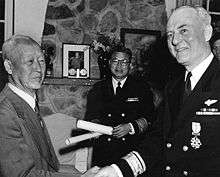
Both Rhee and Kim Il-sung wanted to unite the Korean peninsula under their respective governments, but the United States refused to give South Korea any heavy weapons, to ensure that its military could only be used for preserving internal order and self-defense.[29] By contrast, Pyongyang was well equipped with Soviet aircraft, vehicle, and tanks. According to John Merrill, "the war was preceded by a major insurgency in the South and serious clashes along the thirty-eighth parallel," and 100,000 people died in "political disturbances, guerrilla warfare, and border clashes".[30]
At the outbreak of war on 25 June 1950, North Korean troops launched a full-scale invasion of South Korea. All South Korean resistance at the 38th parallel was overwhelmed by the North Korean offensive within a few hours. By 26 June, it was apparent that the Korean People's Army (KPA) would occupy Seoul. Rhee stated, "Every Cabinet member, including myself, will protect the government, and parliament has decided to remain in Seoul. Citizens should not worry and remain in their workplaces."[31] However, Rhee had already left the city with most of his government on 27 June. At midnight on 28 June, the South Korean military destroyed the Han Bridge, thereby preventing thousands of citizens from fleeing. On 28 June, North Korean soldiers occupied Seoul.
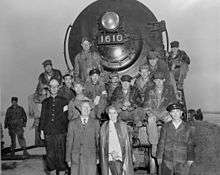
During the North Korean occupation of Seoul, Rhee established a temporary government in Busan and created a defensive perimeter along the Naktong Bulge. A series of battles ensued, which would later be known collectively as the Battle of Naktong Bulge. After the Battle of Inchon in September 1950, the North Korean military was routed, and the United Nations (UN)—of whom the largest contingents were the Americans and South Koreans—not only liberated all of South Korea, but overran much of North Korea. In the areas of North Korea taken by the UN forces, elections were supposed to be administered by the United Nations but instead were taken over and administered by the South Koreans. Rhee insisted on Bukjin Tongil – ending war by conquering North Korea, but after the Chinese entered the war in November 1950, the UN forces were thrown into retreat.[32] During this period of crisis, Rhee ordered the December massacres of 1950. Rhee was absolutely committed to reunifying Korea under his leadership and strongly supported MacArthur's call for going all-out against China, even at the risk of provoking a nuclear war with the Soviet Union.[33]
Hastings notes that, during the war, Rhee's official salary was equal to $37.50 (U.S. dollars) per month. Both at the time and since, there has been much speculation about precisely how Rhee managed to live on a salary equivalent to $37.50 per month. The entire Rhee regime was notorious for its corruption, with everyone in the government from the President downwards stealing as much they possibly could from both the public purse and aid from the United States. The Rhee regime engaged in the "worst excesses of corruption," with the soldiers in the Army of the Republic of Korea (ROK) going unpaid for months as their officers embezzled their pay, equipment provided by the United States being sold on the black market, and the size of the ROK army being bloated by hundreds of thousands of "ghost soldiers" who only existed on paper, allowing their officers to steal pay that would have been due had these soldiers actually existed. The problems with low morale experienced by the ROK army were largely due to the corruption of the Rhee regime. The worst scandal during the war—indeed of the entire Rhee government—was the National Defense Corps Incident. Rhee created the National Defense Corps in December 1950, intended to be a paramilitary militia, comprising men not in the military or police who be drafted into the corps for internal security duties. In the months that followed, thousands of National Defense Corps men either starved or froze to death in their unheated barracks, as the men lacked winter uniforms. Even Rhee could not ignore the deaths of so many of the National Defense Corps and ordered an investigation. It was revealed that commander of the National Defense Corps, General Kim Yun Gun, had stolen millions of American dollars that were intended to heat the barracks and feed and clothe the men. General Kim and five other officers were publicly shot at Daegu on 12 August 1951, following their convictions for corruption.[34]
In the spring of 1951, Rhee—who was upset about MacArthur's dismissal by President Truman—lashed out in a press interview against Britain, whom he blamed for MacArthur's sacking.[35] Rhee was absolutely committed to reunifying Korea under his leadership and strongly supported MacArthur's call for going all-out against China, even at the risk of provoking a nuclear war with the Soviet Union. Rhee declared, "The British troops have outlived their welcome in my country." Shortly thereafter, Rhee told an Australian diplomat about the Australian troops fighting for his country, "They are not wanted here any longer. Tell that to your government. The Australian, Canadian, New Zealand and British troops all represent a government which is now sabotaging the brave American effort to liberate fully and unify my unhappy nation."[35]
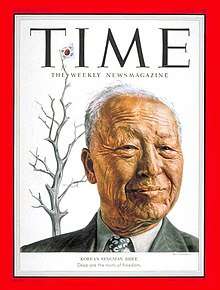
Rhee was strongly against the armistice negotiations the U.S. entered into in 1953. Accordingly, in April of the same year, he demanded of President Eisenhower a total withdrawal of his troops from the peninsula if an armistice were to be signed, declaring that the ROK would rather fight on its own than negotiate a cease-fire. He also deliberately carried out some actions that would deter the armistice and reignite conflicts in the region, the most provocative one being his unilateral release of 25,000 prisoners of war in June 1953.[36] Such actions, which hindered the progress of armistice talks, upset China and the North. Moreover, for such unpredictability in his authoritarian leadership, the Truman and Eisenhower administrations considered him one of the "rogue allies" in East Asia and engaged in "powerplay", or the construction of asymmetric alliances, which helped the U.S. maximize economic and political influence over the ROK and increase ROK's dependency on the United States.[37]
On 27 July 1953, at last, "one of the 20th century's most vicious and frustrating wars"[38] came to an end with no apparent victor. Ultimately, the armistice agreement was signed by military commanders from China, North Korea and the United Nations Command, led by the U.S.[39] Its signatories did not include the ROK, however, as Rhee refused to agree to the armistice, and neither was it supposed to be a permanent cease-fire, as a peace treaty was never signed.
Re-election
Because of widespread discontent with Rhee's corruption and political repression, it was considered unlikely that Rhee would be re-elected by the National Assembly. To circumvent this, Rhee attempted to amend the constitution to allow him to hold elections for the presidency by direct popular vote. When the Assembly rejected this amendment, Rhee ordered a mass arrest of opposition politicians and then passed the desired amendment in July 1952. During the following presidential election, he received 74% of the vote.[40]
Resignation and exile
After the war ended in July 1953, South Korea struggled to rebuild following nationwide devastation. The country remained at a Third World level of development and was heavily reliant on U.S. aid.[41] Rhee was easily re-elected for what should have been the final time in 1956, since the 1948 constitution limited the president to two consecutive terms. However, soon after being sworn in, he had the legislature amend the constitution to allow the incumbent president to run for an unlimited number of terms, despite protests from the opposition.[42]
In March 1960, the 84-year-old Rhee won his fourth term in office as President. His victory was assured with 100% of the vote after the main opposition candidate, Cho Byeong-ok, died shortly before the 15 March elections.[43][44]
Rhee wanted his protégé, Lee Ki-poong, elected as Vice President—a separate office under Korean law at that time. When Lee, who was running against Chang Myon (the ambassador to the United States during the Korean War, a member from the opposition Democratic Party) won the vote with a wide margin, the opposition Democratic Party claimed the election was rigged. This triggered anger among segments of the Korean populace on 19 April. When police shot demonstrators in Masan, the student-led April Revolution forced Rhee to resign on 26 April.[43]
On 28 April, a DC-4 belonging to the United States Central Intelligence Agency (CIA), piloted by Captain Harry B. Cockrell Jr. and operated by Civil Air Transport, covertly flew Rhee out of South Korea as protesters converged on the Blue House.[45] During the flight, Rhee and Francesca Donner, his Austrian wife, came up to the cockpit to thank the pilot and crew. Rhee's wife offered the pilot a valuable diamond ring in thanks, which was courteously declined. The former president, his wife, and their adopted son subsequently lived in exile in Honolulu, Hawaii.
Personal life and death
Rhee was married to Seungseon Park from 1890 to 1910. Park divorced Rhee shortly after the death of their son Rhee Bong-su in 1908, supposedly because their marriage had no intimacy due to his political activities.
In February 1933, Rhee met Austrian Franziska Donner in Geneva.[46] At the time, Rhee was participating in a League of Nations meeting[46] and Donner was working as an interpreter.[14] In October 1934, they were married[46] in New York City.[14][47] She also acted as his secretary.[46]
Since his only son died young, Rhee had three adopted children throughout his life. The first adopted son was Rhee Un-soo, yet Rhee ended the adoption in 1949[48]. The second adopted son was Lee Kang-seok, eldest son of Lee Ki-poong, who were descendants of Prince Hyoryeong[49][50] and therefore distant cousins of Rhee; but Lee committed suicide in 1960.[51][52] After Rhee exiled, Rhee-In-soo, who is a descendant of Prince Yangnyeong just like Rhee, was adopted by him as his heir.[53]

Rhee died of a stroke on 19 July 1965. A week later, his body was returned to Seoul and buried in the Seoul National Cemetery.[54]
Memorials
Rhee's former Seoul residence, Ihwajang, is currently used for the presidential memorial museum. The Woo-Nam Presidential Preservation Foundation has been set up to honor his legacy. There is also a memorial museum located in Hwajinpo near Kim Il Sung's cottage.
In popular culture
- Portrayed by Lee Chang-hwan in the 1991–1992 MBC TV series Eyes of Dawn.
- Portrayed by Kwon Sung-deok in the 2006 KBS1 TV series Seoul 1945.
- In the M*A*S*H episode titled "Mail Call Again", Radar mentions a parade in Seoul due to Syngman Rhee being "elected dictator again."
- Rhee is referenced in the lyrics to singer Billy Joel's 1989 music single, "We Didn't Start the Fire".[55]
Works
See also
- List of Korea-related topics
- President of South Korea
- Francesca Donner
- Inha University
- Korean independence movement
- Korean National Association
Notes
- In 1910, the Korean Peninsula was officially annexed by the Empire of Japan.
- He did participate in the meeting as the Korean representative.
References
- "South Korea owns up to brutal past – World – smh.com.au". www.smh.com.au.
- Kollontai, Ms Pauline; Kim, Professor Sebastian C. H.; Hoyland, Revd Greg (2 May 2013). Peace and Reconciliation: In Search of Shared Identity. Ashgate Publishing, Ltd. p. 111. ISBN 978-1-4094-7798-3.
- Cha (2010), p. 174
- 이승만 [李承晩] [Rhee Syngman]. Doopedia (in Korean). Doosan Corporation. Retrieved 12 March 2014.
- "Syngman Rhee". Encyclopædia Britannica. Retrieved 13 March 2014.
- "Syngman Rhee: First president of South Korea". CNN Student News. CNN. Retrieved 13 March 2014.
- "Syngman Rhee". The Cold War Files. Cold War International History Project. Archived from the original on 14 March 2014. Retrieved 13 March 2014.
- Cha, Marn J. (19 September 2012) [1996], "SYNGMAN RHEE'S FIRST LOVE" (PDF), The Information Exchange for Korean-American Scholars (IEKAS) (12–19): 2, ISSN 1092-6232, retrieved 14 March 2014
- 이승만 [Rhee Syngman]. Encyclopedia of Korean culture (in Korean). Academy of Korean Studies. Retrieved 13 March 2014.
- Breen, Michael (18 April 2010). "Fall of Korea's First President Syngman Rhee in 1960". The Korea Times. KoreaTimes.co.kr. Retrieved 14 March 2014.
- Yu Yeong-ik (유영익) (1996). 이승만의 삶과 꿈 [Rhee Syngman's Life and Dream] (in Korean). Seoul: Joong Ang Ilbo Press. pp. 40–44. ISBN 89-461-0345-0.
- Coppa, Frank J., ed. (2006). "Rhee, Syngman". Encyclopedia of modern dictators: from Napoleon to the present. Peter Lang. p. 256. ISBN 978-0-8204-5010-0.
- Jessup, John E. (1998). "Rhee, Syngman". An encyclopedic dictionary of conflict and conflict resolution, 1945–1996. Greenwood Publishing Group. p. 626. ISBN 978-0-313-28112-9.
- Breen, Michael (2 November 2011). "(13) Syngman Rhee: president who could have done more". The Korea Times. KoreaTimes.co.kr. Retrieved 7 April 2014.
- O'Toole, George Barry; Tsʻai, Jên-yü (1939). The China Monthly. China Monthly, Incorporated. p. 12.
- "Japan surrenders". History. A+E Networks. Retrieved 7 April 2014.
- Cumings, Bruce (2010). "38 degrees of separation: a forgotten occupation". The Korean War: a History. Modern Library. p. 106. ISBN 978-0-8129-7896-4.
- Hastings, Max (1988). The Korean War. Simon and Schuster. pp. 32–34. ISBN 9780671668341.
- – via Wikisource.
- "Details/Information for Canadian Forces (CF) Operation United Nations Commission on Korea". Department of National Defence and the Canadian Armed Forces. 28 November 2008. Retrieved 8 April 2014.
- "South Korea (1948–present)". Dynamic Analysis of Dispute Management Project. University of Central Arkansas. Retrieved 8 April 2014.
- Croissant, Aurel (2002), "Electoral Politics in South Korea" (PDF), Electoral politics in Southeast & East Asia, 370, VI, Singapore: Friedrich-Ebert-Stiftung, pp. 234–237, ISBN 978-981-04-6020-4, retrieved 8 April 2014
- Kyung Moon Hwang A History of Korea Palgrave Macmillan, 2010 page 204.
- Hastings (1988), p. 38
- Hastings (1988), p. 42
- Tirman, John (2011). The Deaths of Others: The Fate of Civilians in America's Wars. Oxford University Press. pp. 93–95. ISBN 978-0-19-538121-4.
- "The National Committee for Investigation of the Truth about the Jeju April 3 Incident". 2008. Archived from the original on February 24, 2009. Retrieved December 15, 2008.
- "South Korea owns up to brutal past – World – smh.com.au". www.smh.com.au.
- Hastings (1988), p.45
- Merrill, John, Korea: The Peninsular Origins of the War (University of Delaware Press, 1989), p181.
- "Ten biggest lies in modern Korean history". The Korea Times. 3 April 2017.
- Kollontai, Ms Pauline; Kim, Professor Sebastian C. H.; Hoyland, Revd Greg (2 May 2013). Peace and Reconciliation: In Search of Shared Identity. Ashgate Publishing, Ltd. p. 111. ISBN 978-1-4094-7798-3.
- Koenig, Louis William (1968). The Chief Executive. Harcourt, Brace & World. p. 228.
- Hastings (1988), p. 235-240
- Hastings (1988), p. 235
- Cha (2010), p. 174
- Cha, Victor D (Winter 2010). "Powerplay: Origins of the U.S. Alliance System in Asia". International Security. MIT Press Journals. 34 (3): 158–196. doi:10.1162/isec.2010.34.3.158.
- James E. Dillard. “Biographies: Syngman Rhee”. The Department of Defense 60th Anniversary of Korean War Commemoration Committee. Retrieved on 28 September 2016.
- "The Korean War armistice”. BBC News. 5 March 2015. Retrieved on 28 September 2016.
- Buzo, Adrian (2007). The making of modern Korea. Taylor & Francis. p. 79. ISBN 978-0-415-41482-1.
- Snyder, Scott A. (2 January 2018). South Korea at the Crossroads: Autonomy and Alliance in an Era of Rival Powers. Columbia University Press. p. 33. ISBN 978-0-231-54618-8.
- Kil, Soong Hoom; Moon, Chung-in (1 March 2010). Understanding Korean Politics: An Introduction. SUNY Press. p. 143. ISBN 978-0-7914-9101-0.
- Han, S-J. (1974) The Failure of Democracy in South Korea. University of California Press, p. 28–29.
- Lentz, Harris M. (4 February 2014). Heads of States and Governments Since 1945. Routledge. ISBN 978-1-134-26490-2.
- Cyrus Farivar (2011), The Internet of Elsewhere: The Emergent Effects of a Wired World, Rutgers University Press, p. 26.
- 프란체스카 [Francesca]. Encyclopedia of Korean culture (in Korean). Academy of Korean studies. Retrieved 7 April 2014.
- "KOREA: The Walnut". TIME. 9 March 1953. Retrieved 20 March 2010.
In 1932, while attempting to put Korea's case before an indifferent League of Nations in Geneva, Rhee met Francesca Maria Barbara Donner, 34, the daughter of a family of Viennese iron merchants. Two years later they were married in a Methodist ceremony in New York.
- 정병준 (2005). 우남이승만연구. 역사비평사. pp. 56, 64.
- "효령대군파 권37(孝寧大君派 卷之三十七)". 장서각기록유산DB. Retrieved 5 June 2020.
- "전주이씨효령대군정효공파세보 全州李氏孝寧大君靖孝公派世譜". FamilySearch. Retrieved 7 June 2020.
- Choy, Bong-youn (1971). Korea: A History. Tuttle Publishing. p. 352. ISBN 9781462912483.
- Oh, John Kie-chiang (1999). Korean Politics: The Quest for Democratization and Economic Development. Cornell University Press. p. 43. ISBN 0801484588.
- "전주이씨양녕대군파대보 全州李氏讓寧大君派大譜, 2권, 655–1980". FamilySearch. Retrieved 7 June 2020.
- Dijk, Ruud van; Gray, William Glenn; Savranskaya, Svetlana; Suri, Jeremi; Zhai, Qiang (1 May 2013). Encyclopedia of the Cold War. Routledge. ISBN 978-1-135-92310-5.
- We Didn't Start the Fire. BillyJoel.com. Retrieved 25 September 2016.
Further reading
- Appleman, Roy E. (1998), South to the Naktong, North to the Yalu: United States Army in the Korean War, Washington, D.C.: Department of the Army, ISBN 978-0-16-001918-0
- Fields, David. Foreign Friends: Syngman Rhee, American Exceptionalism, and the Division of Korea. University Press of Kentucky, 2019, 264 pages, ISBN 978-0813177199
- Lew, Yong Ick. The Making of the First Korean President: Syngman Rhee's Quest for Independence (University of Hawai'i Press; 2013); scholarly biography; 576 pages;
- Shin, Jong Dae, Christian F. Ostermann, and James F. Person (2013), North Korean Perspectives on the Overthrow of Syngman Rhee, Washington, D.C.: North Korea International Documentation Project
External links
| Wikimedia Commons has media related to Syngman Rhee. |
- Syngman Rhee's FBI files hosted at the Internet Archive
| Preceded by King of Norway Haakon VII |
The oldest current head of state 21 September 1957 – 26 April 1960 |
Succeeded by Pope John XXIII |
| Political offices | ||
|---|---|---|
| First Establishment of the Republic |
President of the Provisional Government of the Republic of Korea 11 September 1919 – 21 March 1925 |
Succeeded by Park Eunsik |
| Preceded by Kim Kyu-sik |
Chairmen of the Interim Legislative Assembly 1948 |
Succeeded by Himself as Speaker of the Constituent Assembly |
| Preceded by Himself as Chairmen of the Interim Legislative Assembly |
Speaker of the National Constituent Assembly 1948 |
Succeeded by Shin Ik-hee |
| Preceded by Kim Gu |
President of the Provisional Government of the Republic of Korea 1947–1948 |
Succeeded by Syngman Rhee (President of South Korea) |
| Preceded by Syngman Rhee as President of the Provisional Government |
1~3rd President of South Korea 24 July 1948 – 26 April 1960 |
Succeeded by Heo Jeong (Acting) |
